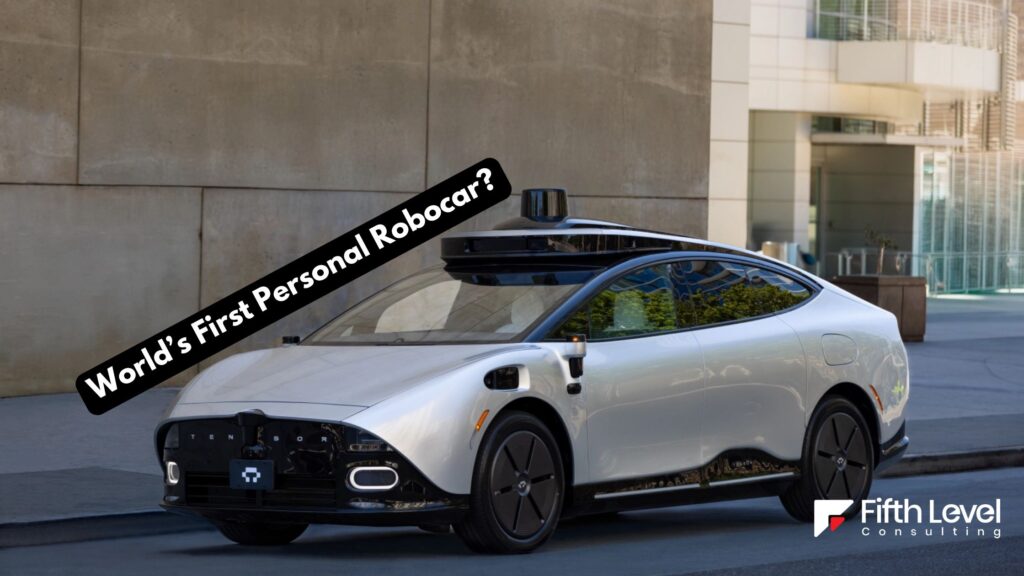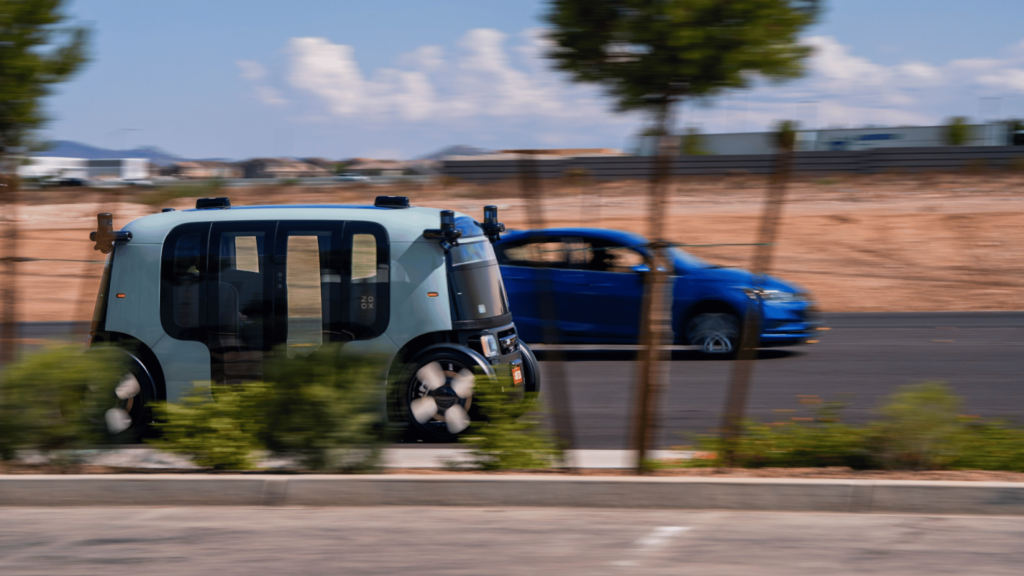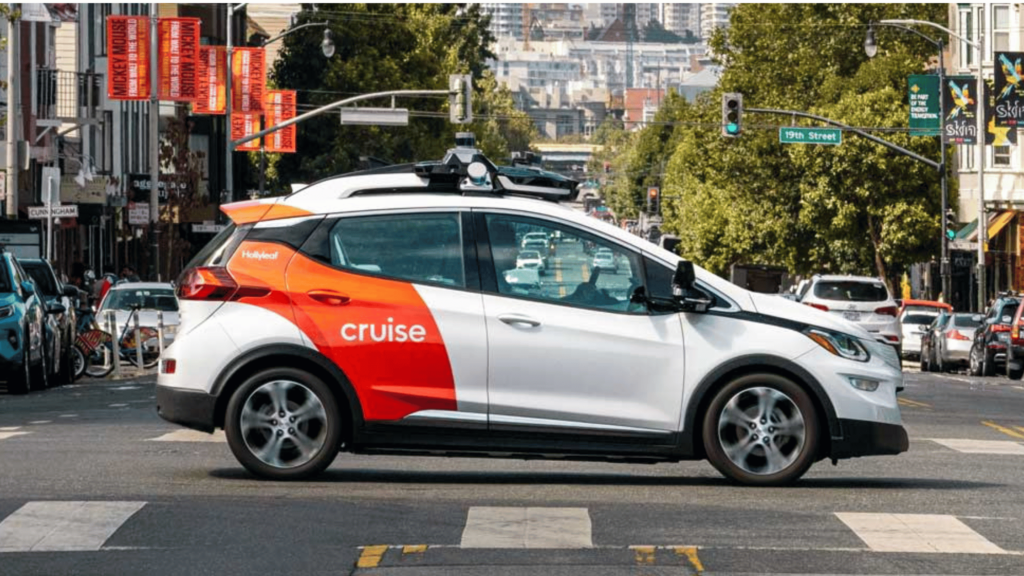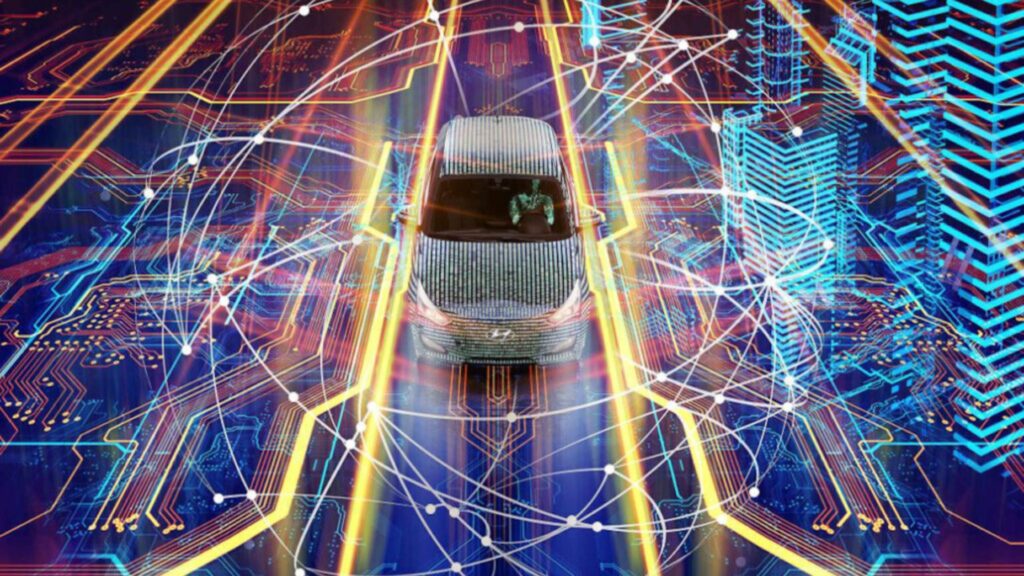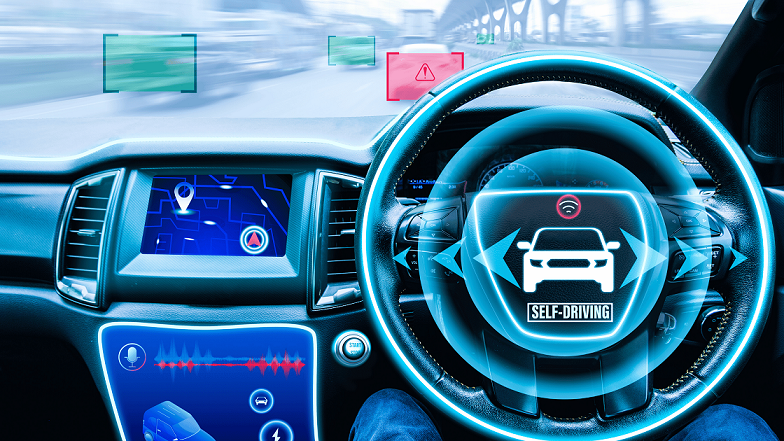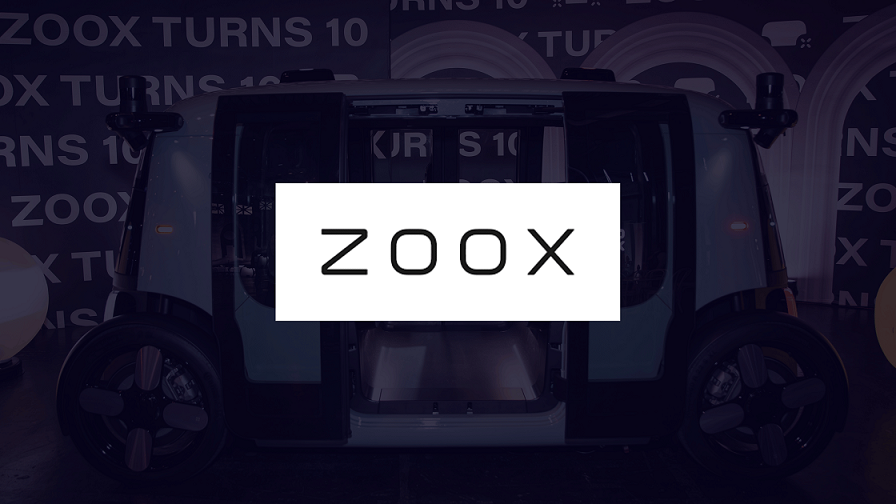The future of personal self-driving transportation is here, and it’s being shaped by Tensor, a pioneering U.S.-based autonomous vehicle (AV) startup. Tensor is on a mission to build the world’s first personal robocar (T1 Robocar). Unlike ride-hailing AVs from companies like Waymo or Tesla, Tensor’s vision is centered on personal autonomy—giving individuals the freedom to own and operate their own self-driving cars.
“When the world shifts… how will you move?” said Amy Luca, Chief Marketing Officer at Tensor. “We are building a world where individuals own their personal AGI agents, enhancing freedom, privacy and autonomy. With Tensor, we’re introducing the world’s first personal Robocar, ushering in the era of AI defined vehicles. This isn’t a car as we know it. It’s an embodied personal agent that moves you. It’s time to Own Your Autonomy.”
Tensor Robocar Specs Snapshot
- Level: SAE L4 (dual-mode: drive or be driven)
- Compute: ~8,000 TOPS, 10 GPUs, 144 cores
- 37 cameras for all-around visual perception
- 5 lidars for depth mapping in all light conditions
- 11 radars for long-range object detection
- 22 microphones
- 10 ultrasonic sensors for close-range awareness
- 3 IMUs and GNSS for precise navigation
- 16 collision detectors to sense impact risks
- 8 water level sensors for flood detection
- 4 tire pressure monitors
- 1 smoke detector for onboard safety
- Three-channel 5G for ultra-fast, redundant connectivity
- Charging: 845V, 5C, 20–80% in ~10 min (claimed)
- Manufacturing partner: VinFast (Hai Phong)
- Insurance partner: Marsh
- Deliveries: H2 2026 (target)
Tensor’s upcoming personal Robocar is packed with more sensors than most production AVs on the road today. This massive sensor suite is what powers its Level 4 autonomous capabilities and enables the “agentic AI” experience the company is promising.
The Tensor Robocar operates at SAE Level 4, meaning it can drive itself without human intervention in specific geofenced areas, such as highways, arterials, or designated urban zones, under defined conditions like clear weather. For unsupported roads or extreme conditions, owners can switch to manual driving, ensuring flexibility.
This geofenced approach allows Tensor to deploy reliable autonomy in controlled environments while expanding coverage through future updates. The hybrid model—autonomous in supported areas, manual elsewhere—makes the robocar a practical choice for consumers mentally and physically transitioning to self-driving technology.
The Tensor Robocar is fully equipped with an NVIDIA-powered onboard supercomputer delivering 8,000 trillion operations per second (TOPS). This computing muscle, paired with redundant safety systems, ensures the AV can process massive amounts of sensory data instantly—making split-second driving decisions even in complex urban environments.
Let’s dive deep into 10 key facts about Tensor and its groundbreaking robocar, exploring its technology, heritage, and potential to build the world’s first personal robocar.
Ten Key Facts About the Tensor Robocar
1. First Personal Level 4 Autonomous Vehicle

On August 13, 2025, Tensor introduced the world’s first Level 4 autonomous vehicle designed for private ownership, a milestone that sets it apart in the crowded autonomous vehicle (AV) industry. Unlike robotaxis built for shared fleets, the Tensor Robocar is crafted for individuals, offering full autonomy in specific conditions without requiring a safety driver.
According to the Society of Automotive Engineers (SAE), Level 4 autonomy means the vehicle can handle all driving tasks within designated areas, such as highways or urban zones, under certain weather or traffic conditions.
Tensor’s press release proudly declared, “The Tensor Robocar is the first volume-produced, consumer-ready autonomous vehicle—designed from the ground up for private ownership at scale.”
This focus on personal ownership distinguishes Tensor from competitors like Waymo, Tesla, and Zoox, who prioritize ride-hailing services. It’s a pivotal moment that brings the dream of a self-driving personal vehicle closer to reality for consumers in the U.S., Europe, and UAE, with deliveries planned for late 2026.
2. A Rebrand of AutoX with a Consumer-Centric Vision

Tensor was birth from AutoX, a Chinese-American company founded in 2016 that gained recognition for its robotaxi services in China. AutoX deployed over 1,000 robotaxis in Shenzhen’s suburbs, earning a reputation for robust autonomous technology. However, Tensor spokesperson Lena Allen said the company had wound down all its Chinese operations, with all offices closed and operations shut down. The AutoX brand and its China operations have been fully discontinued, she stated.
Tensor represents a strategic pivot, rebranding AutoX’s expertise to focus on personal robocars for global markets. It’s a Silicon Valley-based startup that plans to be the first company to sell “a true robocar.” While AutoX operated in China’s ride-hailing ecosystem, Tensor targets individual buyers in the U.S., Europe, and UAE, leveraging a decade of AV experience to craft a vehicle that prioritizes ownership over shared mobility.
3. Over 100 Sensors

The Tensor Robocar’s sensor suite is a technological wonder, featuring over 100 integrated sensors to ensure precise navigation and safety. This includes 37 high-resolution cameras, 5 lidar units, 11 radars, 22 microphones, and 10 ultrasonic sensors, complemented by 16 collision detectors, 8 water-level detectors, and a smoke detector.
“With over 100 seamlessly integrated sensors, Tensor offers uncompromised visibility—free from the constraints of legacy vehicle design,” the company stated.
Unlike Tesla’s vision-only approach, which relies solely on cameras, Tensor’s multi-sensor strategy emphasizes redundancy and robustness, enabling the robocar to detect obstacles, pedestrians, and road conditions in challenging environments like fog or heavy rain. The inclusion of microphones allows for voice command recognition and external sound analysis, while water-level detectors ensure safe navigation during floods. The sensor suite positions Tensor’s robocar as one of the most perceptive autonomous vehicles ever designed.
4. Proprietary AI Driving System: TensorDrive
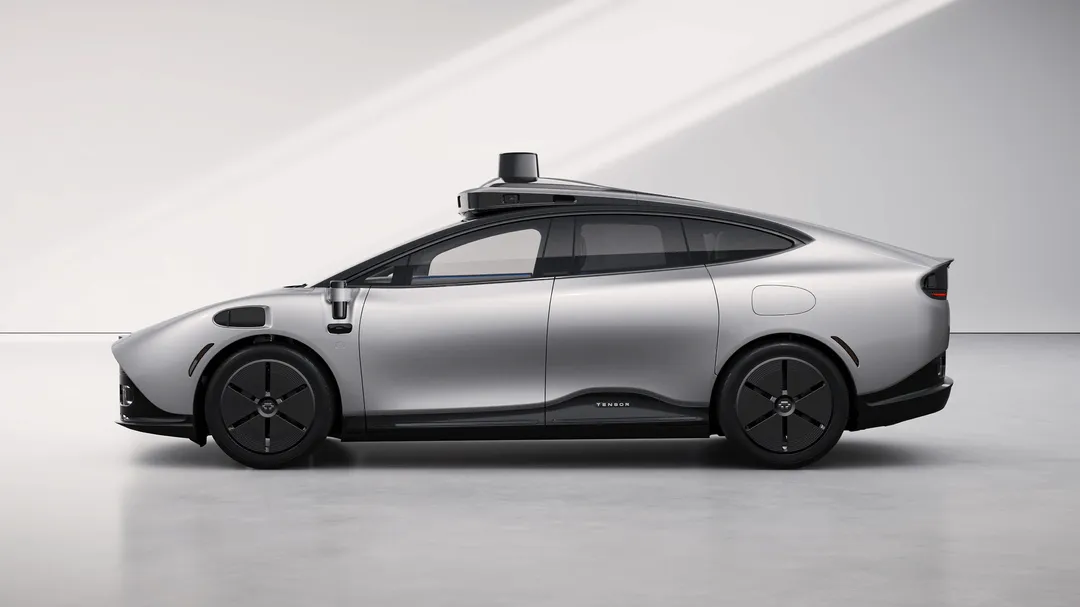
Tensor’s self-driving technology, TensorDrive, is built in-house and claims superior decision-making in complex urban environments.
It uses:
- Multimodal sensors (lidar, radar, cameras).
- Neural networks trained on 10+ million miles of real-world and simulated driving.
- Over-the-air (OTA) updates for continuous improvement.
5. Unparalleled Privacy Experience
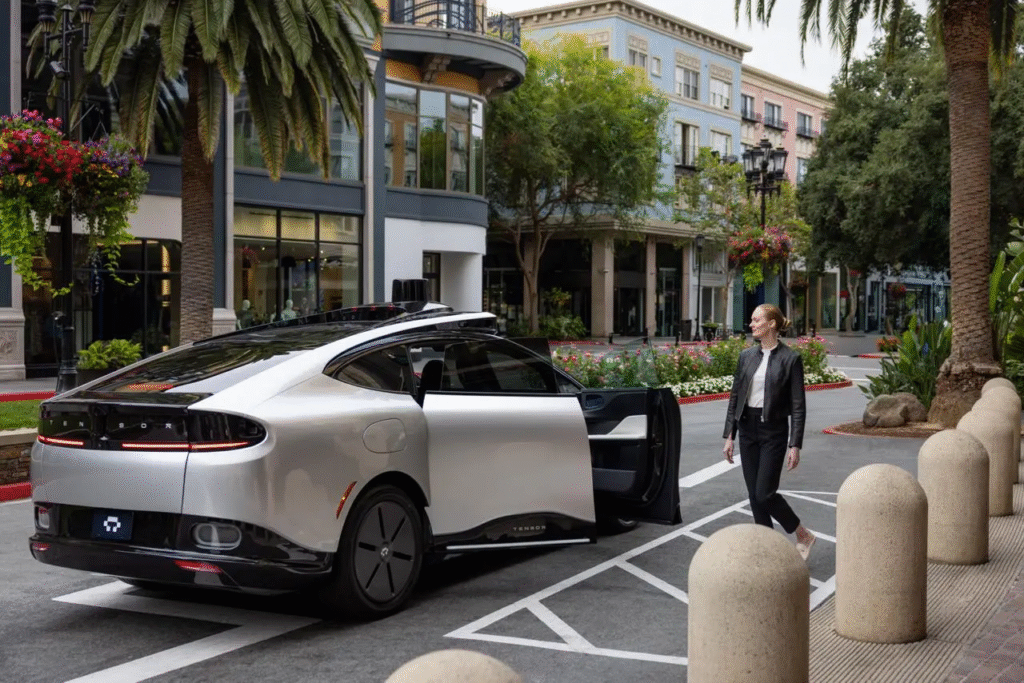
Tensor is making privacy a cornerstone of its robocar. All user data—location, driving patterns, preferences, and voice commands—is processed and stored locally on the vehicle, eliminating reliance on cloud servers vulnerable to breaches. Physical camera covers and microphone off switches provide tangible control, while data access is restricted to an encrypted smartphone app or the onboard interface. This approach contrasts sharply with many tech-driven vehicles that collect and transmit data to remote servers.
6. A Luxurious Design
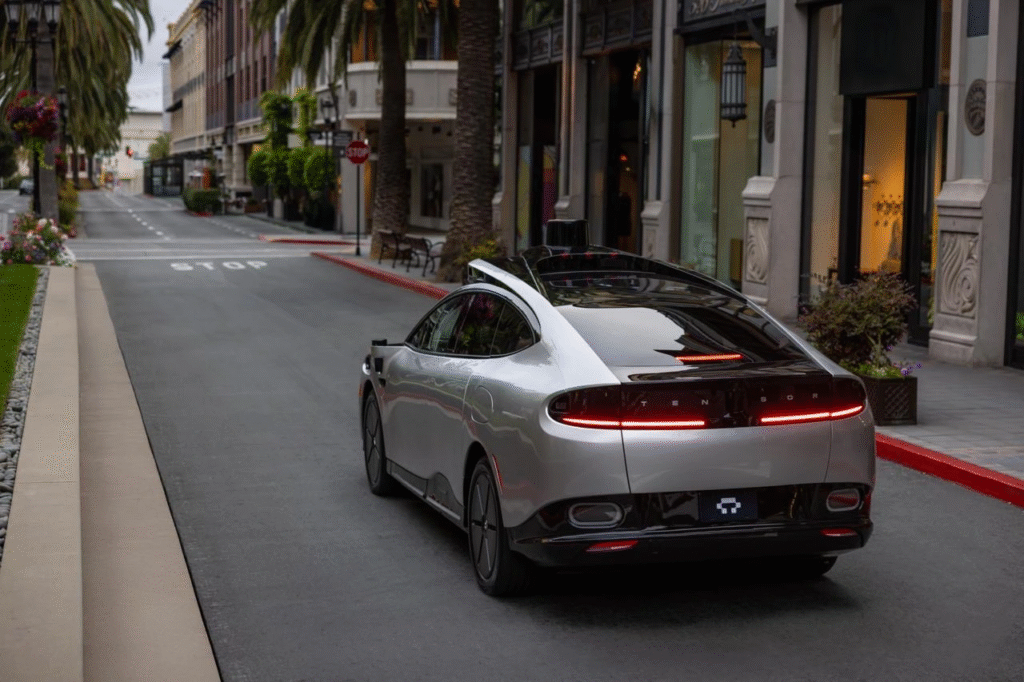
Beyond its technological sophistication, the Tensor Robocar is a statement of style and functionality. Designed in collaboration with Vietnamese automaker VinFast, the vehicle features a sleek, futuristic aesthetic with a spacious interior that prioritizes comfort. The steering wheel folds away, and pedals retract to create a lounge-like cabin, while a sliding touchscreen serves as the central interface. The robocar supports both autonomous and manual driving, catering to owners who want the option to take the wheel on unsupported roads.
With a planned launch in late 2026 across the U.S., Europe, and UAE, this robocar combines luxury and function, offering a versatile solution for modern mobility.
You May Also Like:
Will the Lyft and Tensor Robocar Partnership Work?
7. Transformative Interior Configuration

One of Tensor’s most distinctive features is its adaptive interior design. The personal robocar’s steering wheel is foldable — tucking away when the vehicle is operated autonomously. This innovative approach allows the vehicle to seamlessly transition between manual and autonomous driving modes.

The vehicle includes a retractable steering wheel and pedals, as well as a touchscreen that can be moved from the center to the driver’s position on the driver’s side. When operating in manual mode, drivers have access to a yoke steering wheel with the touchscreen positioned centrally to display driving data. However, if the driver selects autonomous Level 4 mode, the steering wheel retracts into the console, the pedals also retract, and the touchscreen moves to optimize the passenger experience.
8. Backed by Top Investors
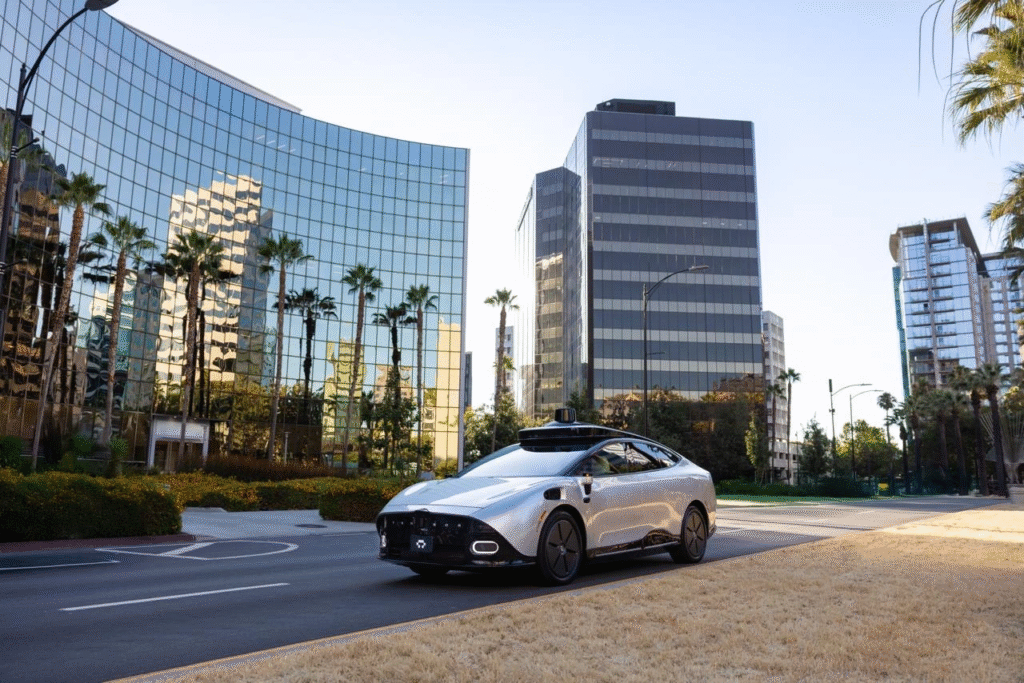
Tensor has raised $300 million in Series B funding (2025) from leading tech investors, including:
- Sequoia Capital (early backers of Apple, Google, Nvidia).
- Andreessen Horowitz (investors in Tesla, SpaceX).
- Former Tesla executives, including an ex-Autopilot lead.
This strong financial backing validates Tensor’s potential to compete with giants like Waymo, Zoox, and Tesla.
9. Advanced Agentic AI Integration
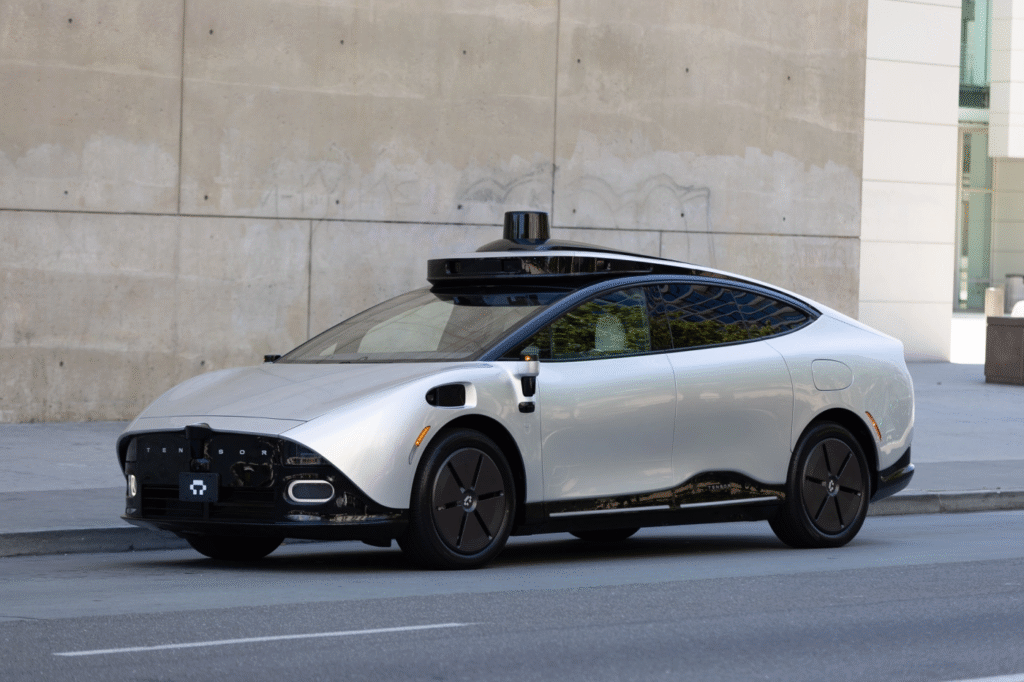
Tensor has integrated sophisticated artificial intelligence that goes beyond traditional voice commands. Tensor is using agentic AI to initiate and complete tasks. The system synthesizes data from cameras, microphones and other sensors inside the vehicle’s cabin to interact with passengers and respond when they speak in a conversational tone — not just when they use specific linguistic prompts like many voice assistants built into things like smart speakers and phones.
The AI system’s capabilities are enhanced by its comprehensive sensor network, which processes multiple data streams simultaneously to create a more intuitive and responsive user experience. This represents a significant advancement over conventional automotive AI systems relying on predetermined command structures.
10. Shifting the Paradigm from Robotaxis to Ownership

While companies like Waymo and Tesla dominate the robotaxi space, Tensor is charting a new course by focusing on personal ownership.
“While today’s autonomous vehicles are primarily built as RoboTaxis—heavily maintained, depot-dependent fleets—Tensor represents a radical departure,” the company stated.
The robocar is designed for self-reliance, with features like autonomous parking, self-diagnostic tools, and over-the-air software updates that minimize maintenance needs. This consumer-centric approach empowers owners to integrate autonomy into their daily lives without relying on fleet operators. By prioritizing individual ownership, Tensor is democratizing access to advanced AV technology, a laudable business model.
Also, Tensor is positioning itself to outpace Tesla in delivering the first consumer-owned Level 4 autonomous vehicle, with a target launch in the second half of 2026.
“Tensor Wants To Beat Tesla to the Punch With the First L4 ‘Robocar’ Sold to the Public,” reported autoevolution.
Key differences Between Tensor Robocar, Waymo Robotaxi, and Tesla Robotaxi
| Feature / Aspect | Tensor Robocar (Personal L4) | Waymo Robotaxi (L4 fleet) | Tesla Robotaxi (Vision-only pilot) |
|---|---|---|---|
| Sensor Suite | Over 100 sensors: 37 cameras, 5 lidars, 11 radars, 22 mics, ultrasonics, IMUs, GNSS, collision detectors, water-level sensors, TPMS, smoke detector, triple-channel 5G. | 6th-gen: 13 cameras, 4 lidar, 6 radar, array of external audio receivers. | Vision-only: 8 surround cameras, forward radar, ultrasonic sensors (12–? depending on version), GPS & IMU. |
| Compute / Processing | NVIDIA-based supercomputer: ~8,000 TOPS with redundancy. | Proprietary compute; speculated to use NVIDIA GPUs or Google’s TPUs; costly system (est. sensors + compute ~$150k–200k) | Tesla HW4 FSD Computer 2: ~36+ TOPS per SoC, dual redundant, power-efficient (~150 W each) |
| Level of Autonomy | Level 4, for private ownership leveraging full autonomy systems. | Level 4, driverless operation in several cities (Phoenix, SF, LA, Austin) | Currently Level 2/3 pilot: safety monitor inside; not fully driverless. |
| Deployment & Scale | Planned for H2 2026 in US, Europe, UAE; aimed at individual buyers. | Operating hundreds of vehicles, millions of miles, thousands of weekly trips (100k+ trips/week). | Pilot launched June 2025 in Austin with ~10–20 vehicles, geofenced area, safety monitor aboard. |
| Hardware & Sensor Philosophy | High-redundancy with full sensor suite for safety and functionality. Emphasizes onboard processing & privacy. | Multi-sensor fusion (cameras, lidar, radar, audio) optimized for cost without sacrificing redundancy. | Minimalist “vision-only” approach aimed at cost-efficiency and scalability, at risk in adverse environmental conditions. |
| Price / Cost | Unknown public price. Likely high due to heavy sensor/compute hardware. | Estimated hardware cost ~$150k–200k per vehicle. | Tesla projects future sub-$25k Robotaxi; current hardware embedded in consumer vehicles. |
| Unique Features / Positioning | First personal L4 Robocar for individual ownership; full-stack redundancy; agentic AI concept. | Trusted, mature service with extensive real-world testing; heavily sensor-redundant; safe in diverse weather. | Vision-centric, OTA-updatable, leveraging massive data scale; still under supervision with human monitor. |
The Future of Mobility with Tensor
The Tensor Robocar is a vision of a future where autonomy, privacy, and luxury merge to redefine personal mobility. With its advanced AI, robust sensor suite, and focus on individual ownership, Tensor wants to challenge industry giants and pave the way for a new era of transportation.
This AV startup is redefining personal mobility by putting autonomous driving in the hands of individual owners. It’s amazing how far the autonomous vehicle industry has come. With strong investor backing from the likes of Sequoia Capital and a clear roadmap, Tensor’s T1 robocar could mark the beginning of a new era in transportation.
You May Also Like:
6 Best Self-Driving Cars in the US (2025)
Top 5 Autonomous Trucking Companies in the US (2025)
Waymo’s 100 Million Autonomous Miles: A Timeline of How They Got Here
Drunk Driving Fatalities in the US: Autonomous Vehicles to the Rescue

I’m Dr. Brandial Bright, also known as the AVangelist. As a dedicated and passionate researcher in autonomous and electric vehicles (AVs and EVs), my mission is to educate and raise awareness within the automotive industry. As the Founder and Managing Partner of Fifth Level Consulting, I promote the adoption and innovation of advanced vehicle technologies through speaking engagements, consulting, and research as we progress to level 5 fully autonomous vehicles.

